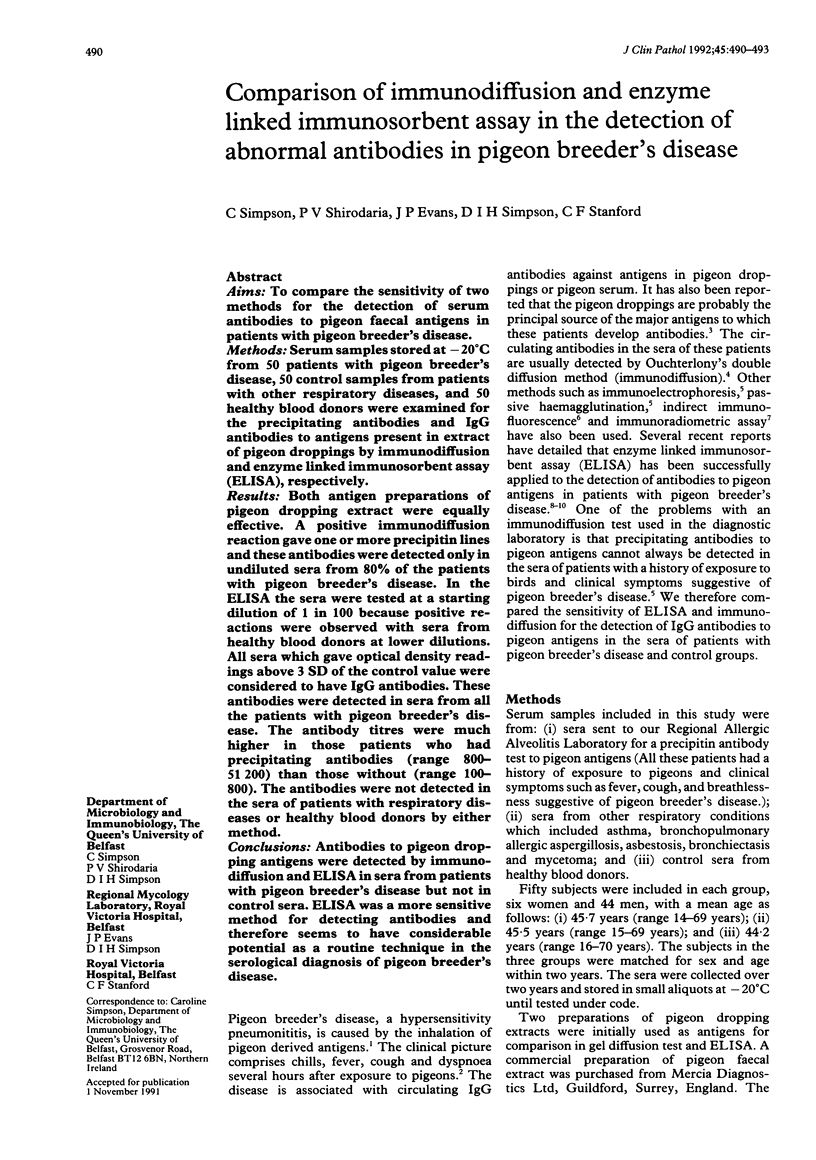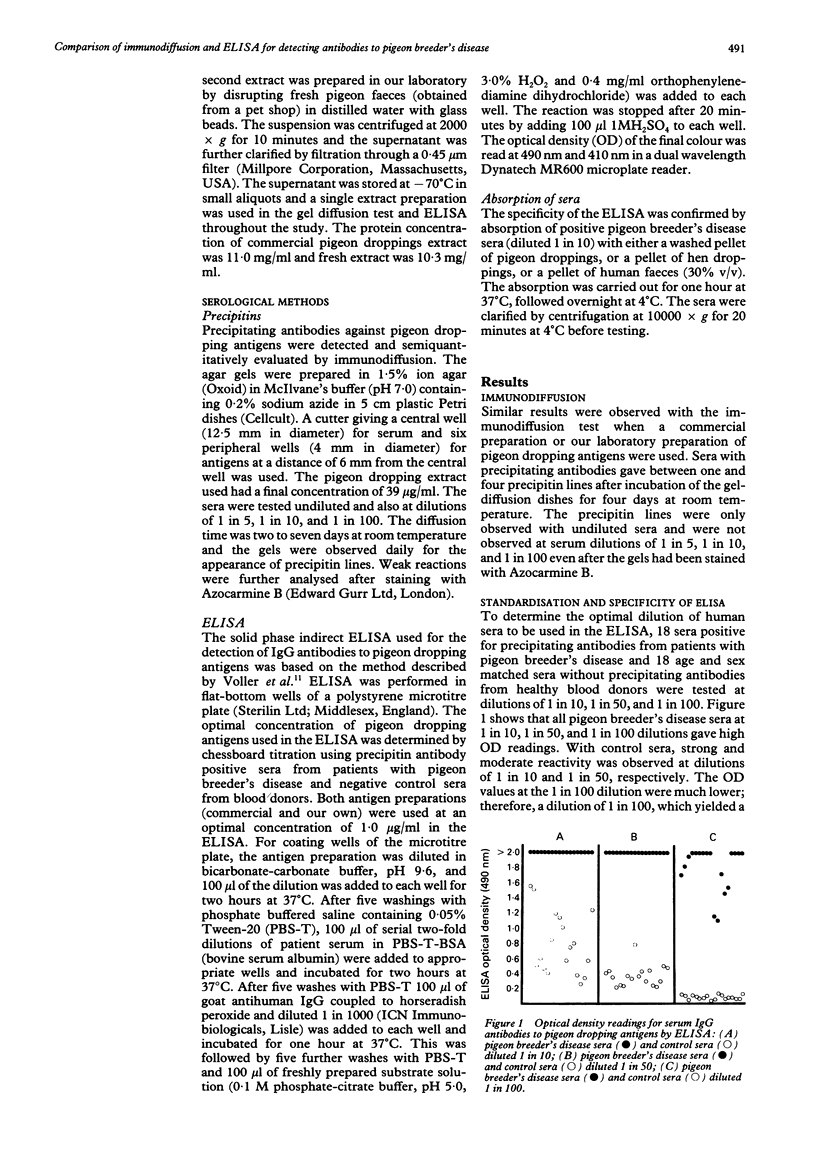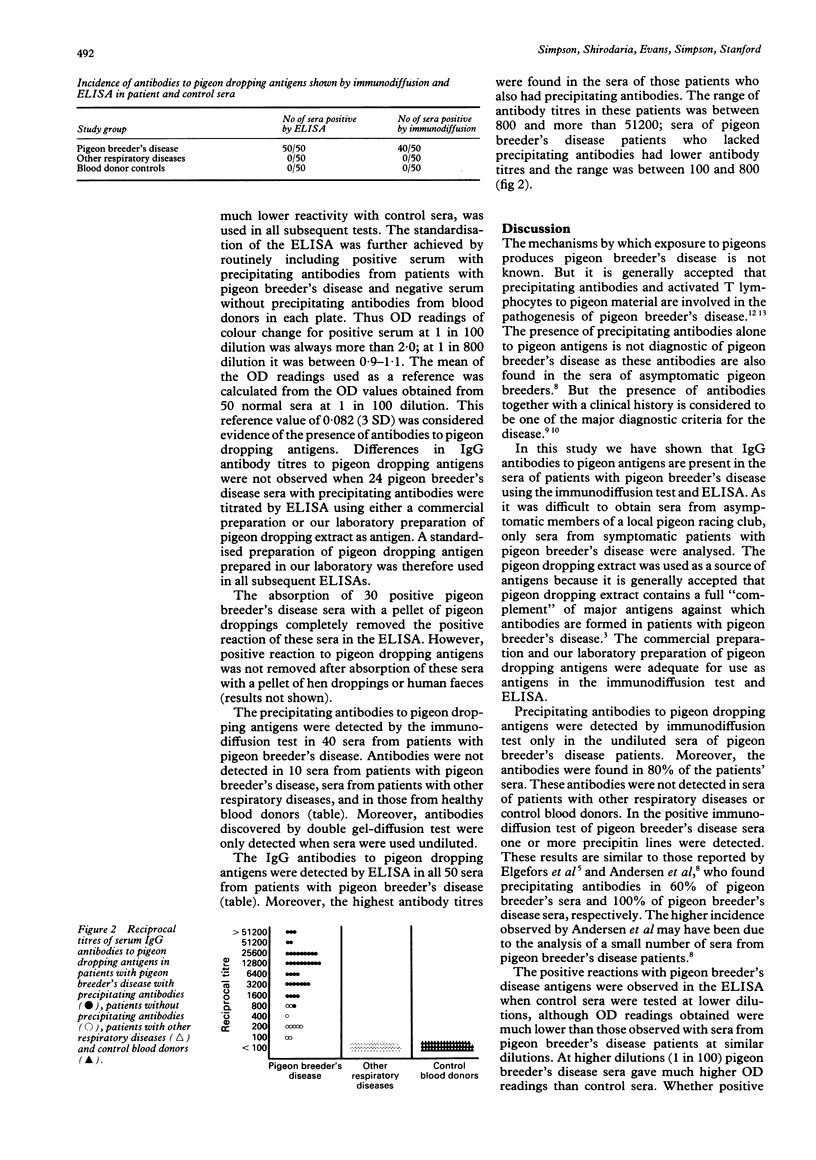Abstract
AIMS: To compare the sensitivity of two methods for the detection of serum antibodies to pigeon faecal antigens in patients with pigeon breeder's disease. METHODS: Serum samples stored at -20 degrees C from 50 patients with pigeon breeder's disease, 50 control samples from patients with other respiratory diseases, and 50 healthy blood donors were examined for the precipitating antibodies and IgG antibodies to antigens present in extract of pigeon droppings by immunodiffusion and enzyme linked immunosorbent assay (ELISA), respectively. RESULTS: Both antigen preparations of pigeon dropping extract were equally effective. A positive immunodiffusion reaction gave one or more precipitin lines and these antibodies were detected only in undiluted sera from 80% of the patients with pigeon breeder's disease. In the ELISA the sera were tested at a starting dilution of 1 in 100 because positive reactions were observed with sera from healthy blood donors at lower dilutions. All sera which gave optical density readings above 3 SD of the control value were considered to have IgG antibodies. These antibodies were detected in sera from all the patients with pigeon breeder's disease. The antibody titres were much higher in those patients who had precipitating antibodies (range 800-51,200) than those without (range 100-800). The antibodies were not detected in the sera of patients with respiratory diseases or healthy blood donors by either method. CONCLUSIONS: Antibodies to pigeon dropping antigens were detected by immunodiffusion and ELISA in sera from patients with pigeon breeder's disease but not in control sera. ELISA was a more sensitive method for detecting antibodies and therefore seems to have considerable potential as a routine technique in the serological diagnosis of pigeon breeder's disease.
Full text
PDF



Selected References
These references are in PubMed. This may not be the complete list of references from this article.
- Bourke S., Anderson K., Lynch P., Boyd J., King S., Banham S., Boyd G. Chronic simple bronchitis in pigeon fanciers. Relationship of cough with expectoration to avian exposure and pigeon breeders' disease. Chest. 1989 Mar;95(3):598–601. doi: 10.1378/chest.95.3.598. [DOI] [PubMed] [Google Scholar]
- Boyd G., McSharry C. P., Banham S. W., Lynch P. P. A current view of pigeon fancier's lung. A model for pulmonary extrinsic allergic alveolitis. Clin Allergy. 1982 Oct;12 (Suppl):53–59. [PubMed] [Google Scholar]
- Costabel U., Bross K. J., Marxen J., Matthys H. T-lymphocytosis in bronchoalveolar lavage fluid of hypersensitivity pneumonitis. Changes in profile of T-cell subsets during the course of disease. Chest. 1984 Apr;85(4):514–522. doi: 10.1378/chest.85.4.514. [DOI] [PubMed] [Google Scholar]
- Eade O. E., Hodges J. R., Berrill W. T., Lang C., Lloyd R. S., Wright R. Immunofluorescent antibodies in patients with bird-fancier's lung. Clin Exp Immunol. 1978 May;32(2):259–262. [PMC free article] [PubMed] [Google Scholar]
- Edwards J. H., Barboriak J. J., Fink J. N. Antigens in pigeon breeders' disease. Immunology. 1970 Nov;19(5):729–734. [PMC free article] [PubMed] [Google Scholar]
- Elgerfors B., Belin L., Hanson L. A. Pigeon breeder's lung. Clinical and immunological observations. Scand J Respir Dis. 1971;52(3):167–176. [PubMed] [Google Scholar]
- Fink J. N., Sosman A. J., Barboriak J. J., Schlueter D. P., Holmes R. A. Pigeon breeders' disease. A clinical study of a hypersensitivity pneumonitis. Ann Intern Med. 1968 Jun;68(6):1205–1219. doi: 10.7326/0003-4819-68-6-1205. [DOI] [PubMed] [Google Scholar]
- LONGBOTTOM J. L., PEPYS J. PULMONARY ASPERGILLOSIS: DIAGNOSTIC AND IMMUNOLOGICAL SIGNIFICANCE OF ANTIGENS AND C-SUBSTANCE IN ASPERGILLUS FUMIGATUS. J Pathol Bacteriol. 1964 Jul;88:141–151. doi: 10.1002/path.1700880119. [DOI] [PubMed] [Google Scholar]
- Orehek J. Asthma without airway hyperreactivity: fact or artifact? Eur J Respir Dis. 1982 Jan;63(1):1–4. [PubMed] [Google Scholar]
- Patterson R., Wang J. L., Fink J. N., Calvanico N. J., Roberts M. IgA and IgG antibody activities of serum and bronchoalveolar fluid from symptomatic and asymptomatic pigeon breeders. Am Rev Respir Dis. 1979 Nov;120(5):1113–1118. doi: 10.1164/arrd.1979.120.5.1113. [DOI] [PubMed] [Google Scholar]
- REED C. E., BARBEE R. A. PIGEON-BREEDERS' LUNG: A NEWLY OBSERVED INTERSTITIAL PULMONARY DISEASE. JAMA. 1965 Jul 26;193:261–265. doi: 10.1001/jama.1965.03090040005001. [DOI] [PubMed] [Google Scholar]
- Rittner C., Sennekamp J., Vogel F. Letter: HLA-B8 in pigeon-fancier's lung. Lancet. 1975 Dec 27;2(7948):1303–1303. doi: 10.1016/s0140-6736(75)90634-0. [DOI] [PubMed] [Google Scholar]
- Sandoval J., Bañales J. L., Cortés J. J., Mendoza F., Selman M., Reyes P. A. Detection of antibodies against avian antigens in bronchoalveolar lavage from patients with pigeon breeder's disease: usefulness of enzyme-linked immunosorbent assay and enzyme immunotransfer blotting. J Clin Lab Anal. 1990;4(2):81–85. doi: 10.1002/jcla.1860040202. [DOI] [PubMed] [Google Scholar]
- Voller A., Bidwell D. E., Bartlett A. Enzyme immunoassays in diagnostic medicine. Theory and practice. Bull World Health Organ. 1976;53(1):55–65. [PMC free article] [PubMed] [Google Scholar]


